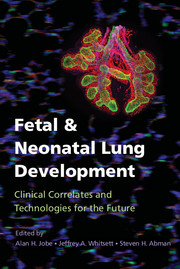Book contents
- Fetal and Neonatal Lung Development
- Lung Growth, Development, and Disease
- Fetal and Neonatal Lung Development
- Copyright page
- Contents
- Contributors
- Preface
- Chapter 1 The Genetic Programs Regulating Embryonic Lung Development and Induced Pluripotent Stem Cell Differentiation
- Chapter 2 Early Development of the Mammalian Lung-Branching Morphogenesis
- Chapter 3 Pulmonary Vascular Development
- Chapter 4 Transcriptional Mechanisms Regulating Pulmonary Epithelial Maturation:
- Chapter 5 Environmental Effects on Lung Morphogenesis and Function:
- Chapter 6 Congenital Malformations of the Lung
- Chapter 7 Lung Structure at Preterm and Term Birth
- Chapter 8 Surfactant During Lung Development
- Chapter 9 Initiation of Breathing at Birth
- Chapter 10 Perinatal Modifiers of Lung Structure and Function
- Chapter 11 Chronic Neonatal Lung Injury and Care Strategies to Decrease Injury
- Chapter 12 Apnea and Control of Breathing
- Chapter 13 Alveolarization into Adulthood
- Chapter 14 Physiologic Assessment of Lung Growth and Development Throughout Infancy and Childhood
- Chapter 15 Perinatal Disruptions of Lung Development:
- Chapter 16 Lung Growth Through the “Life Course” and Predictors and Determinants of Chronic Respiratory Disorders
- Chapter 17 The Lung Structure Maintenance Program: Sustaining Lung Structure during Adulthood and Implications for COPD Risk
- Index
- References
Chapter 17 - The Lung Structure Maintenance Program: Sustaining Lung Structure during Adulthood and Implications for COPD Risk
Published online by Cambridge University Press: 05 April 2016
- Fetal and Neonatal Lung Development
- Lung Growth, Development, and Disease
- Fetal and Neonatal Lung Development
- Copyright page
- Contents
- Contributors
- Preface
- Chapter 1 The Genetic Programs Regulating Embryonic Lung Development and Induced Pluripotent Stem Cell Differentiation
- Chapter 2 Early Development of the Mammalian Lung-Branching Morphogenesis
- Chapter 3 Pulmonary Vascular Development
- Chapter 4 Transcriptional Mechanisms Regulating Pulmonary Epithelial Maturation:
- Chapter 5 Environmental Effects on Lung Morphogenesis and Function:
- Chapter 6 Congenital Malformations of the Lung
- Chapter 7 Lung Structure at Preterm and Term Birth
- Chapter 8 Surfactant During Lung Development
- Chapter 9 Initiation of Breathing at Birth
- Chapter 10 Perinatal Modifiers of Lung Structure and Function
- Chapter 11 Chronic Neonatal Lung Injury and Care Strategies to Decrease Injury
- Chapter 12 Apnea and Control of Breathing
- Chapter 13 Alveolarization into Adulthood
- Chapter 14 Physiologic Assessment of Lung Growth and Development Throughout Infancy and Childhood
- Chapter 15 Perinatal Disruptions of Lung Development:
- Chapter 16 Lung Growth Through the “Life Course” and Predictors and Determinants of Chronic Respiratory Disorders
- Chapter 17 The Lung Structure Maintenance Program: Sustaining Lung Structure during Adulthood and Implications for COPD Risk
- Index
- References
Summary
During lung development, alveolarization and the formation of the vast capillary network require the coordinate interactions of several growth factors during different stages of lung organ building; prominent among those are FGF10, PDGF, and epithelially secreted VEGF. Effective VEGF signaling is also required for the structure maintenance of the adult lung, as genetic modifications in mice and VEGF receptor blockade in adult rats lead to emphysematous airspace enlargement. The remarkable dependence of lung microvascular endothelial cells for their survival on autocrine VEGF signaling is illustrated in the lungs from patients with endstage COPD/emphysema; examination of such lungs shows severely decreased expression of VEGF and of VEGF receptor 1 and 2 proteins and of the VEGF gene upstream transcription factor HIF1 alpha. Copper is required for angiogenesis, and copper depletion causes emphysema in rodents. Thus copper is participating in the maintenance of the adult lung structure also because of its requirement for the activity of the collagen-crosslinking enzyme lysyl oxidase and the oxidant defense enzyme CuZn SOD. In addition, the “sphingosine-1-phosphate/ceramide rheostat” plays a role in the homeostasis of the lung structure. Taken together, this chapter provides the background and the rationale for concepts that can explain how genetic defects and environmental challenges can jeopardize the homeostatic lung structure maintenance program and cause destructive lung diseases in the adult.
- Type
- Chapter
- Information
- Fetal and Neonatal Lung DevelopmentClinical Correlates and Technologies for the Future, pp. 303 - 310Publisher: Cambridge University PressPrint publication year: 2016



